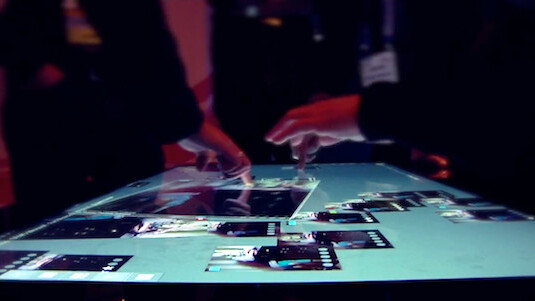
Major companies like Microsoft, Apple and Google will always have their claim to fame, but behind the scenes, the big players know that if they don’t keep pushing the limits and thinking ahead, they’ll eventually be left in the dust.
Sometimes these “pet projects” never take flight, but we’re going to take a look at a few initiatives that have the potential to make waves far beyond the attention they receive today. Here’s a look at how four massive tech companies are quietly innovating for the future:
Microsoft’s Surface
You may think Microsoft has lost the tablet game to the iPad, but there’s an entire market out there that Apple’s tablet will never fully satisfy. With all its glory, the iPad’s instant usability sacrifices complex tools that professionals, particularly creative professionals, need to get things done. This is exactly where Microsoft’s Big Ass Table Surface project, and its latest incarnation, the Surface 2, has true potential.
But as our own Alex Wilhelm notes, “we fretted that the hardware would suffer from a very stiff application drought; who would develop for such a niche product? Of course, any company that intended to use them as an installation could hack up their own app, but who else would hit the code?” Check out this light table application that gives photographers a digital recreation of a classic experience:
http://vimeo.com/industrialcolor/globaledit-app-for-surface-at-nrf-2012
As it turns out, touch screens really have immense potential in the pro space that the iPad will never tap. Given Apple’s love for all things consumer and prosumer, Microsoft has a chance to bypass the iPad entirely with a pro tool for a completely different demographic.
Apple & Education
Sure, everything Apple does lately is broadcasted with a megaphone across the entire tech scene, but for the average consumer, apple’s education push has been rather subtle. Apple’s latest venture into education is not coming out of nowhere; says Apple’s Phil Schiller: ”Education is deep in our DNA, and it has been from the very beginning.”
The iPad has been widely adopted by educational institutions and students. According to Apple, a whopping 1.5 million iPads are already in use in educational programs, and students have over 20,000 education apps to choose from.
 With the latest release of iTunes U, a once great but not always 100% helpful pile of lectures is turning into a new way for teachers and students to interact. What’s really happening here is that Apple is shifting iTunes U into a Blackboard killer (a tool many US universities use as a CMS for classwork and online discussion). And so long as the iPad continue to be integrated into schools, the big guys at Cupertino don’t even have to race towards adoption.
With the latest release of iTunes U, a once great but not always 100% helpful pile of lectures is turning into a new way for teachers and students to interact. What’s really happening here is that Apple is shifting iTunes U into a Blackboard killer (a tool many US universities use as a CMS for classwork and online discussion). And so long as the iPad continue to be integrated into schools, the big guys at Cupertino don’t even have to race towards adoption.
On to integration, Apple’s recent (and quiet) release of Apple Configurator lets schools and businesses manage mass iDevices. It’s an app that should have been available all along, but it’s sure to encourage adoption from schools.
These moves, in addition to Apple’s partnership with textbook manufacturers reveal motives that won’t become obvious to the entire world immediately. Apple wants to be #1 in education, and we may soon find everyone from elementary school youngsters to arrogant college kids ditching textbooks and learning on an iPad.
Google & Transportation
Google has long been known for working on random projects in its Labs, but since that program has shut down to help sharpen the search giant’s focus, the experimental projects that do exist become all the more telling.
This is where Google’s driverless car initiative grabs my attention, as the company has actually lobbied to legalize driverless cars, and has safely completed more than 200,000 miles of computer-led driving without a single accident caused by the computer.
Furthermore, it’s almost as if Google’s work with street view, maps and satellite imagery was done just for this very purpose, as the work the company did and does lines up Google’s driverless car project for success.
It may be a long shot, but the idea of driverless cars aren’t as far in the future as you might think. Google is pushing progress further on this front, and if the company can nail it, Google may have an entirely new space to dominate.
Adobe is future-proofing its next animation tool
I’ve written rather highly of Adobe’s eventual Flash replacement, Adobe Edge. It’s an animation tool that embraces open standards, but allows for many of the same abilities that its proprietary forefather pioneered.
It seems like people have always fought over the longevity of Flash, with some proclaiming its death, while others holding on tight no matter what. The reality is, Flash hasn’t set itself up to last forever, but Adobe has been working away on Edge to turn it into something that could literally never expire (not that anything in tech is ever fully permanent).
The keyword here is open standards. Note, that this isn’t any particular open standard, so that even when the HTML5 (+CSS3+Javascript) craze is replaced, Edge will be able to adapt and progress.
The application is actually built for this purpose, and will likely require a much more active team updating it as technologies change and progress. The point is, keeping the tool and the technology flexible means rich media on the Web could stay in Adobe’s hands for quite some time.
All in all, the lesson here is that all companies can innovate, no matter the size. While smaller startups are leaner and more agile, larger corporations have the benefit of experience, a defined culture and cold hard cash.
There’s no way to know exactly how these initiatives will pay off, but as far as we can see, the above projects are quite promising. We’ll keep a particularly close eye on them as they develop and start to catch the public eye.
Get the TNW newsletter
Get the most important tech news in your inbox each week.





